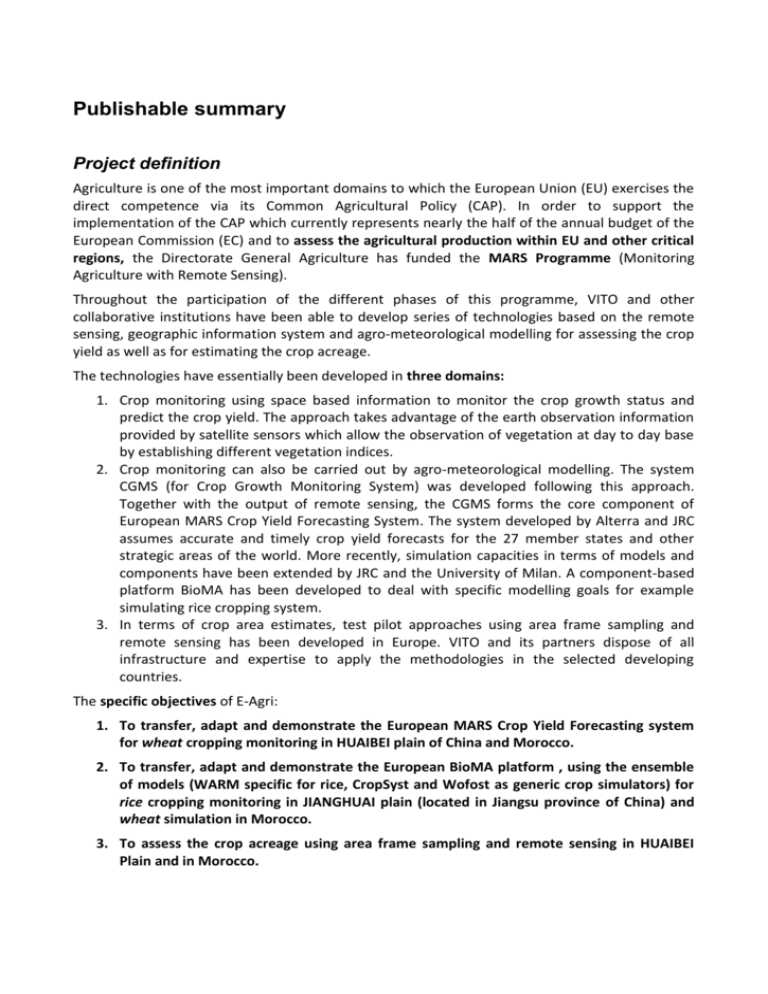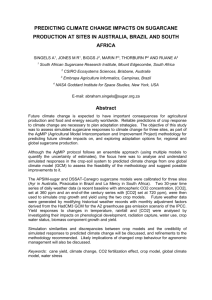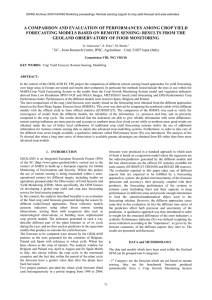Publishable summary
advertisement

Publishable summary Project definition Agriculture is one of the most important domains to which the European Union (EU) exercises the direct competence via its Common Agricultural Policy (CAP). In order to support the implementation of the CAP which currently represents nearly the half of the annual budget of the European Commission (EC) and to assess the agricultural production within EU and other critical regions, the Directorate General Agriculture has funded the MARS Programme (Monitoring Agriculture with Remote Sensing). Throughout the participation of the different phases of this programme, VITO and other collaborative institutions have been able to develop series of technologies based on the remote sensing, geographic information system and agro-meteorological modelling for assessing the crop yield as well as for estimating the crop acreage. The technologies have essentially been developed in three domains: 1. Crop monitoring using space based information to monitor the crop growth status and predict the crop yield. The approach takes advantage of the earth observation information provided by satellite sensors which allow the observation of vegetation at day to day base by establishing different vegetation indices. 2. Crop monitoring can also be carried out by agro-meteorological modelling. The system CGMS (for Crop Growth Monitoring System) was developed following this approach. Together with the output of remote sensing, the CGMS forms the core component of European MARS Crop Yield Forecasting System. The system developed by Alterra and JRC assumes accurate and timely crop yield forecasts for the 27 member states and other strategic areas of the world. More recently, simulation capacities in terms of models and components have been extended by JRC and the University of Milan. A component-based platform BioMA has been developed to deal with specific modelling goals for example simulating rice cropping system. 3. In terms of crop area estimates, test pilot approaches using area frame sampling and remote sensing has been developed in Europe. VITO and its partners dispose of all infrastructure and expertise to apply the methodologies in the selected developing countries. The specific objectives of E-Agri: 1. To transfer, adapt and demonstrate the European MARS Crop Yield Forecasting system for wheat cropping monitoring in HUAIBEI plain of China and Morocco. 2. To transfer, adapt and demonstrate the European BioMA platform , using the ensemble of models (WARM specific for rice, CropSyst and Wofost as generic crop simulators) for rice cropping monitoring in JIANGHUAI plain (located in Jiangsu province of China) and wheat simulation in Morocco. 3. To assess the crop acreage using area frame sampling and remote sensing in HUAIBEI Plain and in Morocco. 4. Creating a network for potential users of CGMS and BioMA platforms to obtain valuable feedback on system applicability. 5. To liaise other European crop monitoring activities such as GMFS, and contribute to strengthen European agricultural intelligence at world-wide level which is primordial for improving the competitive position of European agriculture in the global marketplace. The project entails a research and development (RTD) component and a demonstration (DEMO) component. The RD tasks aim to adapt European technologies to local agrienvironmental conditions and to develop and integrate additional peripheral components if the local stakeholders’ needs arise. The DEMO activities will measure locally the effectiveness of the transferred technologies through an establishment of users’ networks. Finally a capacity building activity specifically designed for East Africa will be organized in Kenya, to pave the way for a further technological transfer. Where are we now? The deployment of project started with series of activities on capacity building and on knowledge dissemination. In order to pave a technical base for local partners, series of workshops and training sessions were organized. On the other hand, dissemination materials and infrastructures are prepared including workshop brochures, project flyer and several dedicated web sites. Finally, collaborations with other international crop monitoring and food security projects have been initiated. Implementation of CGMS yield forecasting (WP2) has largely progressed beyond the schedule for the study area of Morocco. The level 1 operation related to the meteorological data processing is running using the local weather data provided by the Moroccan National Meteorological Department (DMN). An ad hoc visualisation software was derived from the original European viewing software package which requires a quite advanced hardware infrastructure and an important maintenance effort. On Huaibei plain in China, the set-up of CGMS started smoothly by taking advantage of a previous collaboration work with Chinese Academy of Agricultural Sciences. Many results were also obtained in the frame of WP3 aiming establishing biophysical simulation platform BioMA for yield forecasting. The crop varieties were identified in the two test regions. The parameterisation of different models as well as the sensitivity analysis are being carried out. Substantial advance has been achieved for crop yield forecasting using remote sensing indicators (WP4). The most suitable indicators, such as cumulative NDVI and cumulative DMP, have been identified and empirical regression models are created to predict crop yields for the current growth season. The progress enabled the Moroccan partner to publish their first forecasting bulletin national-wide. In the domain of crop area assessment (WP 5) different approaches on segment sampling, and satellite image classification have been analysed at pilot study level. Systematic sampling with stratification seems to produce most cost efficient results. In the domain of satellite image classification, the maximum likelihood classifier proved to be superior. Moreover, JRC and VITO tested a new point frame sampling method to improve the cost-efficiency of area assessment. Investigation will extended to a larger area in the second year. Figure 1: Monitoring crop area changes The activities planned in the WP6 for establishing a statistical toolbox have been advanced to this year as the Moroccan partner needs the tool to produce their bulletin 2012. The main achievement includes the built-up of a statistical analysing chain capable to process most vegetation indicators in Morocco and a migration of the statistical toolbox to Windows 7 environment. In the second year of the project implementation, the technologies can be deployed more extensively (from both technological and geographical points of view) including the running of CGMS at Level 2, first rice yield forecasting based on BioMA platform and validation of the remote sensing indicators at a large area (even beyond the previously defined study zones). The capacity building activities will be started in Kenya as well. The relevance The final results will be the locally adapted versions of European crop monitoring technologies which will contribute to strengthen the European capability on global agriculture information and intelligence. The outcome of the project will also help the local authorities in their agricultural policy making. Read more The project established three web sites. The general promotional site (www.e-agri.info) has objective of disseminating the project outcome (Figure 2). Figure 2: Project’s web site screen capture







